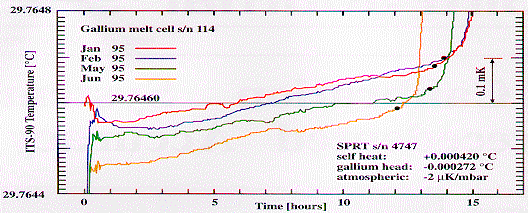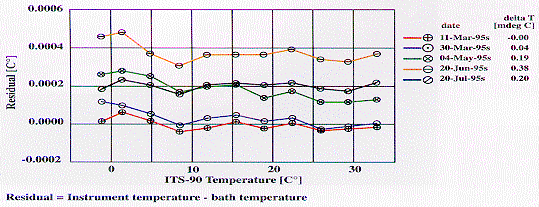![]()
A publication of Sea-Bird Electronics, Inc. Issue #5 August 1995
INNOVATIVE CALIBRATION SYSTEM YIELDS UNPRECEDENTED ACCURACY
|
Metrology Laboratory |
|
New methods and World-class metrology tighten the link between ocean measurements and primary physical standards.
Perfected after four years of research, super-low-gradient computer-controlled baths are producing temperature calibrations with resolution and accuracy not previously available to oceanographers. Parallel efforts to perfect conductivity calibrations are yielding similar results and will be the subject of a future newsletter.
Not only are the new calibration accuracies dramatically superior, but results are obtained in substantially less time, and at lower cost. Extremely well insulated baths provide a uniform toroidal circulation yielding an overall transfer accuracy against an SPRT within 0.0002°C. Repeatability at each of twelve individually mapped sensor positions is better than 0.0001°C.
Sea-Bird's new metrology laboratory underpins the new temperature calibration baths. Following consultation with the U.S. National Institute of Standards and Technology, the met lab was configured to achieve temperature precision of 50 µK and accuracy of 0.0005 °C. To obtain this performance, premium primary references including four Jarrett water triple-point cells (with maintenance bath) and an Isotech gallium melt cell are operated in conjunction with two YSI 8163 standards-grade platinum resistance thermometers and an ASL F18 Automatic Temperature Bridge.
1995 Gallium Melt Point Curves
The precision of Sea-Bird's primary standard is exhibited in plots of gallium melt cycles not yet corrected for the known drift of the Tinsley reference resistor. The melt plateau temperature slope results from gallium impurities and zone refining stresses, with dots marking the uppermost valid plateau temperatures.
1995
Gallium Melt Point Curves

Fifty-four water triple-point certifications during the same five-month period yield a mean of 0.009985 °C and absolute variation of ±60 µK. The certification results support our conclusion that 0.0005 °C absolute accuracy is readily achieved.
1995 Temperature Calibrations - Sea-Bird
SBE 3 Sensor

The excellent performance of the new calibration system is demonstrated in results obtained between March and July 1995 with a production SBE-3 CTD temperature sensor; the plots show a drift of less than 0.0004°C. Note the clearly discernible +1.2 mK per year drift rate that could not be judged in conventional baths typically exhibiting variance at 1 mK+ levels.
Sea-Bird sensors can be separately calibrated because their frequency outputs are true binary signals unaffected by cable resistance, connector properties, or noise. They combine "briefcase-transportability" with never-before-achieved accuracy.
Following a parallel development effort, Sea-Bird is now operating a similarly-automated conductivity calibration system referenced to IAPSO standard seawater and a Guildline 8400B Autosal; a scaled-up version is under development to handle the larger SEACAT instrument types. In addition to duplicating the temperature control features of the Sea-Bird temperature baths, this unique system includes a computer controlled sampler that automatically draws water from the conductivity bath at each bath temperature step. Pumped into separate bottles, the water samples are analyzed upon completion of the calibration. Calibration results from this system are demonstrating successful transfers at 0.001 PSU and absolute accuracies approaching the limits of the salinity standard.
By linking ocean measurements so closely to primary standards, Sea-Bird's new calibration systems offer oceanographers access to a temperature and salinity baseline of unprecedented accuracy.
![]()
Sea-Bird Home Phone: (+1) 425-643-9866 E-mail: seabird@seabird.com